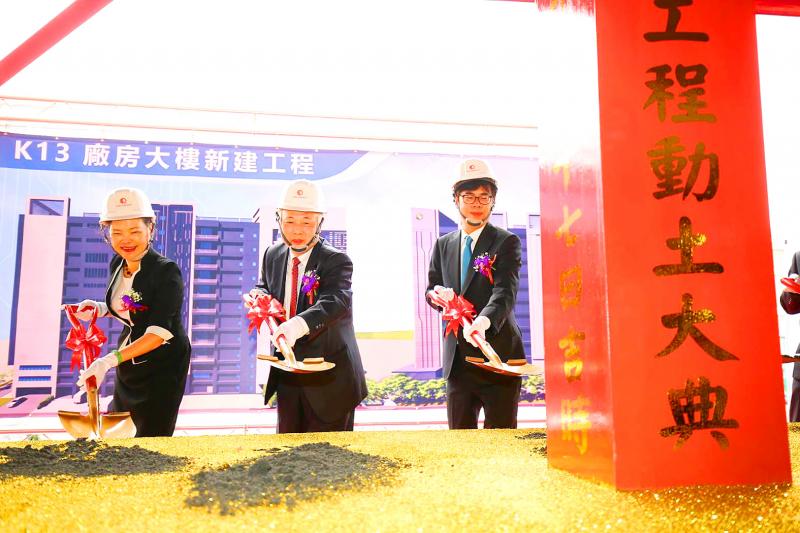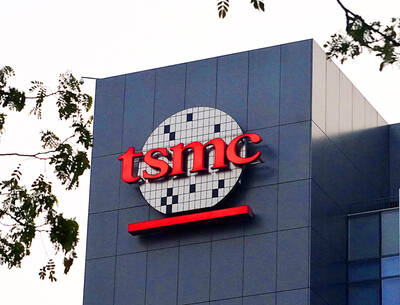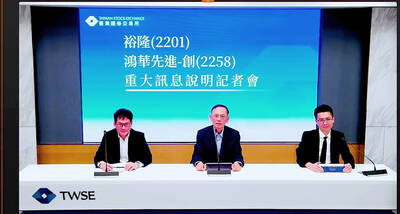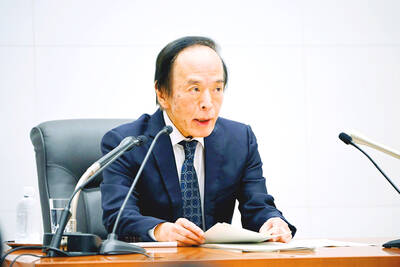ASE Technology Holding Co (ASE, 日月光投控), the world’s biggest chip tester and packager, yesterday said it would invest NT$26 billion (US$880.58 million) in a new fab in Kaohsiung to expand advanced testing and packaging capacity for 5G-related chips.
The new fab, code-named K13, is part of the company’s broader plan to build six fabs in Taiwan within five years, ASE said.
As rapidly developing 5G technology is stimulating demand for semiconductors, ASE said it is stepping up investment and adding advanced technology capacity to capture the “explosive” growth of the supply chain.

Photo: Lee Hui-chou, Taipei Times
“5G is a new technology, which is to bring explosive growth to businesses. ASE would continue to invest in advanced process technologies and hire research and development experts in Kaohsiung to capitalize on this opportunity for the semiconductor industry,” ASE chief executive officer Tien Wu (吳田玉) said in a statement.
ASE is positive about its long-term prospects in the semiconductor industry, as 5G technology, artificial intelligence, smart manufacturing and electric vehicles are likely to drive semiconductor growth over the next few years, Wu said in June.
The company plans to invest NT$8 billion in fab construction and add another NT$18 billion for further capacity expansion. The fab is scheduled to become operational in 2023.
The K13 fab is forecast to contribute US$500 million a year to revenue and create 2,800 jobs when it reaches full capacity, the Kaohsiung-based company said.
For this year, the company plans to spend US$1.6 billion on new facilities and equipment, on par with last year’s level, while its global peers scaled back capital spending by a combined US$700 million, it said.
The capacity expansion plan came as ASE runs most of its factories at, or near full capacity, thanks to strong demand, mostly from its communications segment, the company told investors on July 31.
The company said it expects revenue from its core chip assembly, testing and material business this quarter to grow 5 percent quarterly.
However, overall revenue this quarter would still face the effects of US restrictions on using US technology and software to produce chips abroad, it said.
The US restrictions are to take effect on Sept. 14.

Taiwan’s long-term economic competitiveness will hinge not only on national champions like Taiwan Semiconductor Manufacturing Co. (TSMC, 台積電) but also on the widespread adoption of artificial intelligence (AI) and other emerging technologies, a US-based scholar has said. At a lecture in Taipei on Tuesday, Jeffrey Ding, assistant professor of political science at the George Washington University and author of "Technology and the Rise of Great Powers," argued that historical experience shows that general-purpose technologies (GPTs) — such as electricity, computers and now AI — shape long-term economic advantages through their diffusion across the broader economy. "What really matters is not who pioneers

In a high-security Shenzhen laboratory, Chinese scientists have built what Washington has spent years trying to prevent: a prototype of a machine capable of producing the cutting-edge semiconductor chips that power artificial intelligence (AI), smartphones and weapons central to Western military dominance, Reuters has learned. Completed early this year and undergoing testing, the prototype fills nearly an entire factory floor. It was built by a team of former engineers from Dutch semiconductor giant ASML who reverse-engineered the company’s extreme ultraviolet lithography (EUV) machines, according to two people with knowledge of the project. EUV machines sit at the heart of a technological Cold

TAIWAN VALUE CHAIN: Foxtron is to fully own Luxgen following the transaction and it plans to launch a new electric model, the Foxtron Bria, in Taiwan next year Yulon Motor Co (裕隆汽車) yesterday said that its board of directors approved the disposal of its electric vehicle (EV) unit, Luxgen Motor Co (納智捷汽車), to Foxtron Vehicle Technologies Co (鴻華先進) for NT$787.6 million (US$24.98 million). Foxtron, a half-half joint venture between Yulon affiliate Hua-Chuang Automobile Information Technical Center Co (華創車電) and Hon Hai Precision Industry Co (鴻海精密), expects to wrap up the deal in the first quarter of next year. Foxtron would fully own Luxgen following the transaction, including five car distributing companies, outlets and all employees. The deal is subject to the approval of the Fair Trade Commission, Foxtron said. “Foxtron will be

INFLATION CONSIDERATION: The BOJ governor said that it would ‘keep making appropriate decisions’ and would adjust depending on the economy and prices The Bank of Japan (BOJ) yesterday raised its benchmark interest rate to the highest in 30 years and said more increases are in the pipeline if conditions allow, in a sign of growing conviction that it can attain the stable inflation target it has pursued for more than a decade. Bank of Japan Governor Kazuo Ueda’s policy board increased the rate by 0.2 percentage points to 0.75 percent, in a unanimous decision, the bank said in a statement. The central bank cited the rising likelihood of its economic outlook being realized. The rate change was expected by all 50 economists surveyed by Bloomberg. The